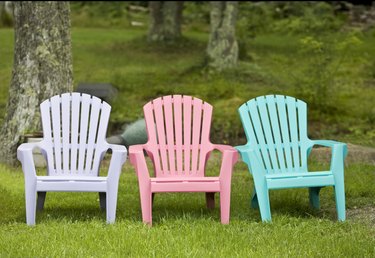
A plastic chair left outside day after day, season after season, eventually looks a little worse for the wear. Bright colors fade, and light colors show dirt and pollution buildup, which may make the chair look a bit grungy even after you clean it. Revamp that unsightly plastic chair with a fresh coat of paint, or give a brand-new chair a color that matches your patio decor. While the painting process isn't complicated, the project requires either a primer designed for plastic or a plastic-specific spray paint that does not require a primer; otherwise, the paint may not adhere.
Crucial Cleaning
Video of the Day
Plastic outdoor furniture attracts dirt outside, whether the piece sits on a patio, on the porch or out in the yard. Brush off loose debris; then hose the chair down from several angles, flipping it over and rinsing the bottom as well. Wash all portions of the chair thoroughly with a household cleaner suitable for plastic, or with a sponge and a warm bucket of soapy water. Rinse the chair again and allow it to dry completely before priming or painting.
Video of the Day
Sand to Make Paint Stick
Sand the entire chair with a fine-grit sandpaper or sanding block, just enough to scuff up the surface, which makes it more receptive to paint. Wipe away the dust with a clean, soft rag.
Time to Prime
Move the project chair away from nearby structures and the rest of your outdoor furniture. Set the chair atop a plastic tarp or sheets of newspaper on a non-windy day; then apply a coat of spray primer designed specifically for plastic. Shake the can and spray the entire chair using a sweeping arm motion, starting each spray blast right before you reach the chair and ending beyond the chair, while holding the can 12 to 18 inches from the plastic. Once the primer dries -- it may take only a few minutes, depending upon the brand -- flip the chair over and prime the areas missed by the first coat. Using a plastic primer allows you to paint the chair with any standard spray paint afterwards. While you could skip the priming and opt for a plastic spray paint that requires no priming, the color range for standard spray paints is vastly greater and includes specialty finishes such as metallic colors.
Spray Paint Perk-Up
Once the primer dries completely, inspect the chair for drips and gently smooth out any you find. Flip the chair over to paint the underside areas first; otherwise, any drips or errors made when finishing up the underside may affect the more visible areas of the chair. Shake the spray paint can -- regular spray paint if you used a primer or a plastic-specific paint if not -- for a minute or so; then apply the paint in thin layers, overlapping each line of paint slightly while holding the can 12 to 18 inches away. Apply additional coats after waiting a few minutes, or as directed on the can; the time may vary from brand to brand. Create stripes for a different look by applying bands of painter's tape once the main color dries; then painting over it again with a second paint shade.